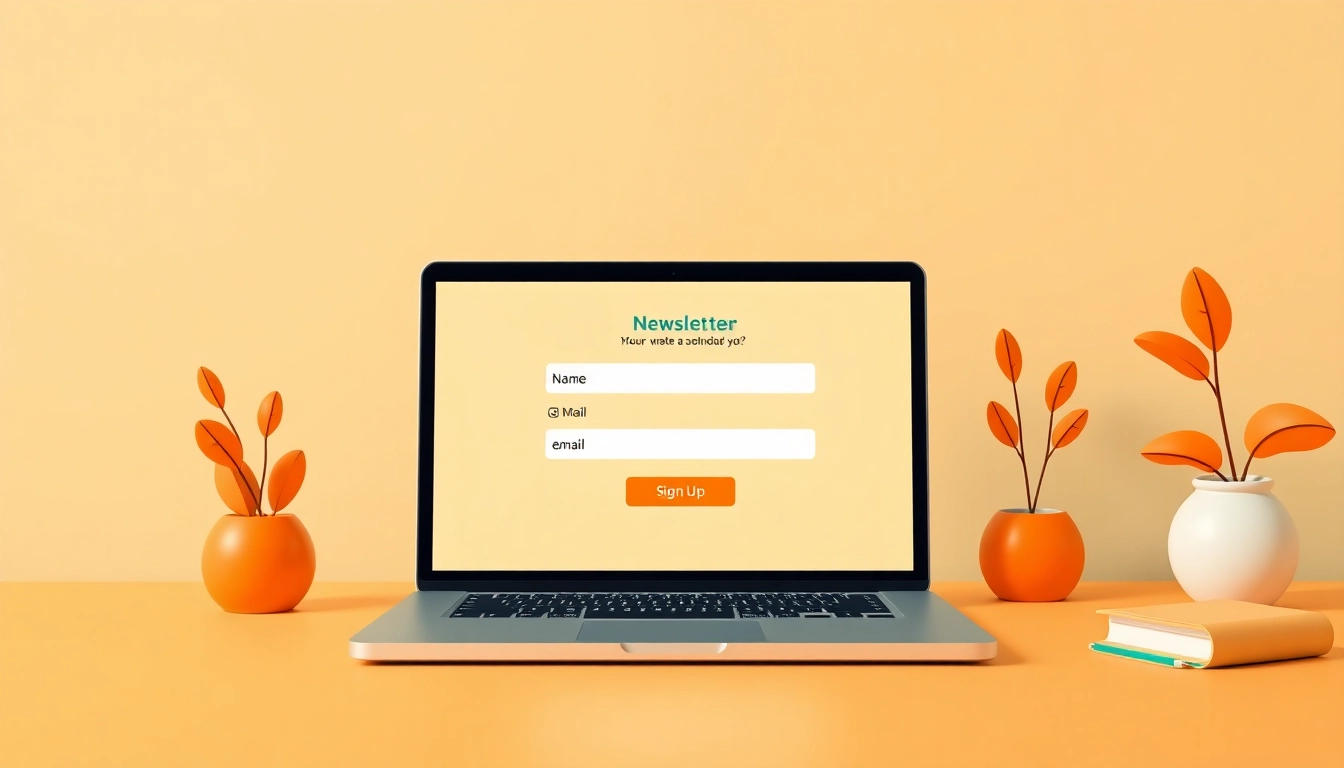Understanding the Importance of Newsletter Signup
In an increasingly digital world, email remains one of the most impactful ways to engage with audiences. As businesses strive to build lasting relationships with customers, newsletter signup has become a critical component of effective marketing strategies. This comprehensive guide delves into the significance of newsletter signups, highlighting their role in business growth, reasons for user subscriptions, and common challenges encountered during the signup process.
The Role of Email Marketing in Business
Email marketing is a powerful tool for driving engagement and conversion. According to numerous studies, email marketing has the highest return on investment (ROI) compared to other digital marketing channels. Businesses can nurture leads and maintain customer relationships through direct communication, fostering loyalty and encouraging repeat purchases. With the ability to segment audiences and personalize content, email marketing allows brands to deliver targeted messages tailored to individual interests and needs.
Why Users Subscribe to Newsletters
Understanding why users subscribe to newsletters is essential for creating compelling signup strategies. Common motivations include:
- Value-driven content: Subscribers seek informative, entertaining, or exclusive content that adds value to their lives.
- Exclusive offers: Many users join newsletters to gain access to special discounts, promotions, or early announcements.
- Community feeling: Newsletters can foster a sense of belonging, providing subscribers with updates and insights from like-minded individuals or brands.
- Education and insights: Many people subscribe to newsletters to stay informed about industry trends, expert opinions, or educational content related to their interests.
Common Challenges in Newsletter Signup
While the benefits of newsletters are clear, many businesses face hurdles when it comes to gaining subscribers. These challenges may include:
- High competition: With countless brands vying for attention, distinguishing a newsletter can be difficult.
- Lack of perceived value: If users do not see compelling reasons to subscribe, they are unlikely to provide their email addresses.
- Compliance issues: Businesses need to navigate laws and regulations surrounding data privacy, such as GDPR, while managing newsletter subscriptions.
- Poor form design: Badly designed signup forms can deter potential subscribers and affect conversion rates.
Best Practices for Newsletter Signup Forms
Creating effective newsletter signup forms requires careful consideration of several factors to ensure maximum conversions. The following best practices can help businesses optimize their signup processes.
Designing an Eye-Catching Signup Form
The design of a signup form plays a crucial role in attracting potential subscribers. Some strategies include:
- Simplicity: A clean and straightforward design encourages user engagement. Avoid clutter and unnecessary fields in the form.
- Visual hierarchy: Use size, color, and font variations to guide users’ attention to the essential elements, such as the signup button.
- Responsive design: Ensure that the signup form is mobile-friendly, as a significant percentage of users access websites via smartphones and tablets.
Placement Strategies for Maximum Visibility
Placement of the signup form can significantly influence its visibility and conversion rates. Here are some effective placement strategies:
- Above the fold: Positioning the signup form at the top of the webpage ensures that more visitors see it without needing to scroll.
- Floating forms: Implementing a floating signup form on the side of the screen can attract user attention while they navigate the site.
- Throughout the content: Embedding signup forms within blog posts or content can encourage subscriptions by offering value before prompting users to sign up.
Crafting Compelling Call-to-Actions (CTAs)
A strong call-to-action (CTA) compels users to take action and subscribe. Tips for creating effective CTAs include:
- Use action-oriented language: Employ strong verbs that encourage immediate action, such as “Join now!” or “Get started today!”
- Highlight benefits: Communicate the value of signing up. For example, “Subscribe for exclusive updates and discounts” informs users what they’ll gain.
- Test different formats: Experiment with different wording, colors, and placements for CTAs to identify which combinations yield the best results.
Incentives That Drive Newsletter Signups
Incentives play a crucial role in persuading users to sign up for newsletters. Businesses can implement various strategies to attract subscribers effectively.
Offering Value Through Unique Content
Providing exclusive content reserved for subscribers can entice more users to sign up. Examples include:
- Exclusive articles or reports: Offer in-depth insights or studies that are only accessible to newsletter subscribers.
- Curated resources: Provide curated lists of tools, guides, or content relevant to subscribers’ interests, enhancing their online experience.
- Member-only podcasts or videos: Create premium content that is only available to newsletter subscribers, making them feel valued.
Utilizing Exclusive Offers to Attract Subscribers
Exclusive offers can be the tipping point for potential subscribers. Strategies include:
- Discounts and promotions: Providing a one-time discount or promotional code upon signup can incentivize users to join.
- Free trials or demos: If applicable, offering a trial of a product or service can encourage users to subscribe and explore the offerings.
- Loyalty rewards: Implementing a loyalty program that rewards subscribers can foster long-term engagement and increase retention rates.
Engaging Users with Contests or Giveaways
Contests and giveaways can effectively generate excitement and encourage signups. Consider these strategies:
- Host a contest: Encourage newsletter signups via a contest where participants have a chance to win a valuable prize related to your brand.
- Run a referral program: Reward subscribers for referring friends to join the newsletter, incentivizing them to spread the word.
- Create urgency: Use time-sensitive contests to encourage quick action, assuring users they will miss out if they don’t sign up.
Analyzing and Improving Signup Form Performance
Once the newsletter signup forms are in place, it is essential to analyze and optimize their performance continuously. Metrics and testing can help enhance effectiveness.
Key Metrics to Track for Effectiveness
Tracking relevant metrics can provide insights into the performance of your signup forms. Important metrics include:
- Conversion rates: Measure the percentage of visitors who complete the signup process versus how many see the form.
- Drop-off rates: Identify points in the signup process where users abandon the form to optimize those sections.
- Subscriber engagement: Monitor opening rates, click-through rates, and unsubscribe rates to evaluate how well the newsletter resonates with subscribers.
A/B Testing Your Newsletter Signup Forms
A/B testing allows businesses to experiment with different elements of their signup forms. Here’s how to conduct effective A/B testing:
- Identify a variable to test: Choose specific elements, such as CTA text, design variations, or form placement, to isolate which changes lead to improved performance.
- Run tests over a significant period: Ensure tests are conducted long enough to gather statistically relevant data that encompasses various traffic patterns.
- Analyze results: Assess the performance of each variation and implement the one that yields the best conversion rates.
Making Data-Driven Adjustments for Better Results
Leveraging data analytics to make informed adjustments can significantly enhance signup form performance. Considerations include:
- Focus on bottlenecks: Use drop-off data to streamline the signup process, simplifying fields or reducing steps as necessary.
- Optimize for mobile: Given the increasing prevalence of mobile browsing, ensure signup forms are mobile-friendly and provide a seamless experience.
- Implement feedback loops: Gather user feedback through surveys or direct queries to identify areas for improvement and make necessary adjustments.
Real-World Examples of Successful Newsletter Signups
Learning from successful implementations in the industry can provide inspiration for optimizing your own newsletter signup process. Here are several case studies and insights from various sectors.
Case Studies of High-Performing Signup Forms
Several brands have successfully maximized their newsletter signups by implementing innovative strategies. Some notable examples are:
- The Skimm: This newsletter effectively utilizes a minimalistic signup form with a strong incentive for new users, which highlights the value of their content.
- BuzzFeed: Through engaging quiz-based content, BuzzFeed creatively embeds signup forms, capturing leads by offering personalized results and recommendations.
Lessons Learned from Various Industries
Different industries offer unique insights into effective newsletter signup strategies. Key lessons include:
- Retail: Brands often integrate exclusive discounts and seasonal promotions directly in their signup forms, creating an enticing proposition for consumers.
- Media: News outlets emphasize clear value propositions, such as breaking news alerts or exclusive insights, to fortify their newsletter appeal.
Inspiration from Top Competitors in Email Marketing
Several competitors have established successful email marketing strategies worth emulating:
- Dribbble: Features visually appealing design elements in its signup forms, effectively capturing the artistic community alongside their core message.
- Mailchimp: Showcases industry-leading email marketing practices by continuously optimizing their signup strategy based on performance and user feedback.



